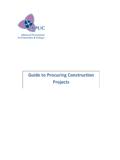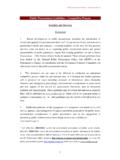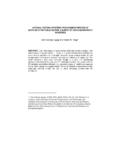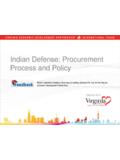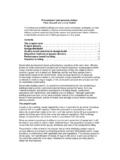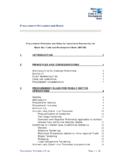Transcription of A Guide to the Development of Procurement Strategies for ...
1 Finance Community of Practice A Guide to the Development of Procurement Strategies for the Scottish College Sector Prepared in partnership and as a joint publication with APUC December 2010 Page | 2 Contents 1. Executive Summary .. 3 3 Aims and Objectives of the Guide .. 3 Conclusions .. 4 2. Why is a Procurement Strategy necessary? .. 4 Managing the Procurement Cycle .. 4 The Need for a Shared Understanding of the Procurement Process .. 5 Setting out the Objectives, Goals and Guiding Principles .. 6 3. The Form and Content of a Procurement Strategy .. 8 Setting the Objectives .. 8 Data Gathering .. 9 4. Sample Procurement Strategies .. 16 One size does not fit all .. 16 Sample Procurement Strategy .. 17 Sample Procurement Strategy .. 22 5. Working Group Membership .. 25 Page | 3 1. Executive Summary Background In 2009-10 all of the institutional members of APUC participated in a Procurement Capability Assessment (PCA) as part of the wider Public Procurement Reform Programme (PPRP) under way in Scotland.
2 The results from PCA were by and large very satisfactory for most universities and colleges. That said, it also emerged that there were certain areas of assessment where improvements to practice and procedure, brought about by the existence of sound Procurement Strategies , could be readily introduced in most institutions. Such improvements would provide focus on Procurement process and function in institutions as key strategic enablers of service design and service delivery. The percentage of institutional expenditure on bought-in goods and services will vary between and within institutions from year to year. Very rarely will it be less than 25% of total expenditure, very often it will be between 30% and 35%, and in years of capital expenditure projects it will exceed well over 50%. The difference between good and bad Procurement can be as high as 15%-20% of costs. Beyond cost considerations, of course, usefully focused Procurement process provides effective management of risk, regulatory compliance, quality, delivery and management of the supply base to optimise delivery of institutional objectives and innovation through the correct use of suppliers know-how as an external resource.
3 The more commonly established approaches to management of purchasing within colleges are sub-optimal in that they:- define purchasing related activity with most emphasis given to procedure rather than policy and objectives; need to be more focused on objectives and how these objectives are derived from, link and align to, the institutional corporate objectives, and need to communicate better how the outcomes from Procurement operations will be assessed in terms of efficiency and performance, how the process is important enough to be usefully measured, valued, managed and deployed in the future. The following Guide proposes a rationale for taking these further steps in the Procurement improvements journey, the issues to evaluate, strategy templates and a few Procurement strategy exemplars to consider. Proportionality is important here and the recommendations made seek to encompass the needs of large, medium and small institutions.
4 Aims and Objectives of the Guide The use of the Guide is intended to provide assistance, where needed, for institutions to introduce more strategically orientated purchasing/ Procurement protocols so that value for money delivery might be optimised and external drivers for improvement addressed comprehensively. Value for money delivery is clearly outlined within the SFC Teaching Funding Methodologies: Funding Principles, Page | 4 Funding principle 12 - able to encourage efficiency within fundable bodies (to) encourage the efficient use of resources so that we can demonstrate clearly that efficiency is embedded in the practices of colleges and HEIs securing value for money and optimum use of public funds. External drivers for improvement are:- The current and medium term economic situation where every effort needs to be made to sustain service delivery through stretch of available funding.
5 Scottish Government expectations, Quotation from John Swinney MSP, Cabinet Secretary for Finance and Sustainable Growth November 17, 2010 How Scotland will achieve efficiencies from improved Procurement in 2011-12 and beyond A continued emphasis on Procurement reform will be central to maximising savings and benefits, as well as recognition of the importance of Procurement as a key strategic enabler of service design and service delivery . The ongoing PCA process and how that falls within the Audit Scotland purview of how progress is being made in the Procurement improvements journey. Conclusions It is recommended that colleges consider the Procurement strategy issue as set out in the Guide :- in relation to the rationale for the recommended approach and, more importantly, in relation to the practical value of adopting a clearly documented Procurement strategy in terms of measurable and managed contributions to the achievement of Procurement , and ultimately institutional, objectives.
6 2. Why is a Procurement Strategy necessary? Managing the Procurement Cycle The PCA Summary Report, produced in July 2010, indicated how the assessment process had provided some useful benchmarks from which institutions might chart their progress with improvements over time. The PCA process also served to highlight areas where APUC should facilitate with peer-assist initiatives or provide focused direct and shared service support; for example, in areas such as Governance linking Procurement strategy and objectives to the institutional plan and objectives; Supplier Strategy and Policy - strengthening supplier and contract management skills; Page | 5 Reporting and KPI measuring the important areas for better leadership and management of Procurement . Furthermore the PCA showed that the primary focus and remit of Procurement activity in the colleges was in the Buying phase (shaded area) of the Procurement cycle depicted below, with too little attention given to the more strategic Planning and Post Contract Award phases.
7 The Need for a Shared Understanding of the Procurement Process An effective Procurement strategy should be based upon a shared understanding of the role and purpose for the Procurement process. Frequently there are different perceptions of this at Principal, senior management, end-user, and supplier levels. These perceptions are also variable between institutions. A shared focus needs to be built upon an alignment of perceptions and understanding around what a college needs from a well performing Procurement process that is consistent with the aims and objectives of the college. Such a role and purpose statement might be something along the lines of:- the role of the Procurement process in each college and across the college sector is developing, securing and sustaining optimal value, in terms of money, efficiency and risk, for institutional needs from resources and external expenditure, to support and enable short and long term teaching, skills training, commercial and occasional research objectives.
8 This kind of statement lends itself to analysis of its constituent elements which in turn can form the separate components of a Procurement strategy with underpinning actions and associated performance indicators. The Procurement strategy can then be suitably aligned within the model institutional objectives cascade depicted below. Page | 6 A Procurement strategy that is successfully integrated and implemented within the institutional cascade of objectives and performance measures should be recognisable by the following characteristics. Clear buy-in at Principal, senior management team and departmental level in each college to the benefits for that college from embracing an agreed role and purpose for the Procurement process and how people need to interact to ensure that outcomes are achieved in a satisfactory manner. Competent professional commercial people playing a key role in the process, at the right interaction points, to ensure delivery of clear solutions from supply markets that meet institutional business needs.
9 Key suppliers who treat the institutions as genuine preferred customers . Processes, systems, measures and enabling structures that support delivery capability along the entire Procurement process cycle. Capacity and capability that are available at the right pressure points. Setting out the Objectives, Goals and Guiding Principles Strategy documents need to outline two key things -- the objectives of the strategy, and the goals which are necessary to achieve these objectives. The goals describe what will actually happen and objectives describe what will be achieved as a result. Page | 7 The guiding principles reflect the core values on which the strategy is based, and which will inform all the actions which are planned as a result. Best value Procurement will be transparent; be driven by desired results; create the most economically advantageous balance of quality and cost; reduce the burden on administrative and monitoring resources; lead to simplified or routine transactions; encourage open and fair competition; follow all appropriate regulations and legislation.
10 These values in turn readily translate into key performance indicators that can be used to assess the quality of results. The objectives and the goals need to reflect the priorities of the institutional mission and be framed in achievable and accountable plans. They need to be no more than 5 to 8 in number, be expressed concisely and easy to understand. They should aspire to be SMART, Specific, Measurable, Achievable, Realistic, and Timed, but they could be very acceptably useful as DUMB, Doable, Understandable, Manageable & Beneficial. The scope of subject matter that might be covered by strategic objectives is described in Section 3. Suggested models that might be suitable for use in larger and smaller colleges, together with web references to several other institutional approaches to Procurement strategy, form and content are commended for consideration in Section | 8 3. The Form and Content of a Procurement Strategy Setting the Objectives There is no short, definitive list of things that ought to be included within Procurement strategy objectives.
